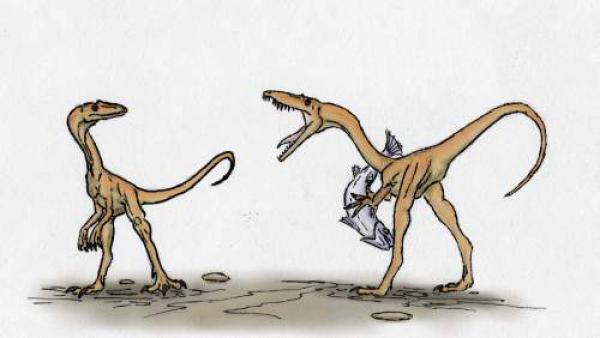BY LETTER
Mesozoic Era
 Image from Luke Campbell |
Geological era, Old Earth, lasting from about 251 million years ago to 65 million years ago, popularly known as the Age of Reptiles (more correctly, Age of Archosaurs).
During this long era of Earth history, the climate was tropical and the continents gathered in only one or a few land-masses (often formed into large islands by the shallow seas). Dinosaurs dominated the land, while ichthyosaurs, plesiosaurs, and other reptiles flourished in the ocean, and pterosaurs in the air. Mammals were common but small and shrew-like, mostly nocturnal. Plants included ferns, equistales ("horsetails"), and gymnosperms like cycads, ginkgo, conifers. Among many types of marine invertebrates, the Cephalopods - particularly the spiral-shelled Ammonites and Belemnites (squid-like forms with an internal shell) - were particularily common . The era opened with a Class 5 mass-extinction and closed with a Class 4 one. The era is divided into three periods - the Triassic, Jurassic, and Cretaceous.
A number of authentic Mesozoic ecosystems have been established using lazurogeneered stock, including the biomes and orbitals of Owen (Utopia Sphere), the Paleo Habitats (FAS), the vast Mesozoic Ring (MPA), and the ever popular complex of Cyberian Dino Virchworlds.
More radically modified Mesozoic environments are found throughout the Archaipelago in the Archosaurian Empire.
Related Articles
- Archosaur - Text by M. Alan Kazlev, with additions by Stephen Inniss
"Ruling Reptile". Important biological clade of terragen vertebrates that rose to prominence in the Mesozoic of Old Earth. It includes crocodilians, dinosaurs, birds, and a number of other extant, extinct or lazurogened types. A number of provolved species are of archosaurian derivation. - ArchSaur (Archailect)
- Cretaceous Period
- Ginkgo
- Icthyosaur - Text by M. Alan Kazlev
Terragen Mesozoic marine reptile, superficially resembling dolphins to a remarkable degree. Have been successfully lazurogened a number of times. The largest populations in terms of both species diversity and individuals are to be found on Owen. - Jurassic Period
- K-T Extinction - Text by M. Alan Kazlev
Terragen mass extinction that occurred 65 million years ago, at the boundary of the Cretaceous and Tertiary periods. Caused by an asteroid or comet impact on the Yucatan Peninsula, resulting in prolonged darkness and rapid global temperature change. It resulted in the extinction of a number of important groups of animal life, including dinosaurs, plesiosaurs, mosasaurs, pterosaurs, ammonites, and several groups of plankton. Plants, small invertebrates, small reptiles and amphibians, small birds, and nocturnal mammals were not unduly affected, and large scavenging reptiles (crocodiles) also were able to survive. The K-T extinction event was a Level IV Mass Extinction. - Triassic Period
Appears in Topics
Development Notes
Text by M. Alan Kazlev
Initially published on 08 December 2001.
Initially published on 08 December 2001.






